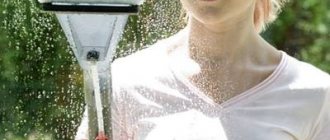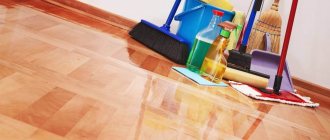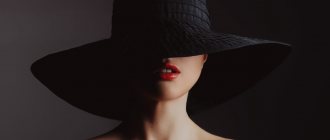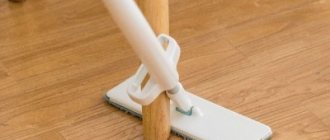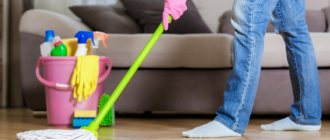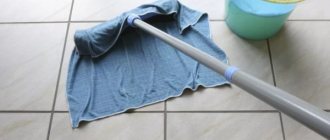Cleanliness of the house carries not only an aesthetic and hygienic, but also an energy load. Old signs say that luck leaves a home in which the floors are not washed for a long time, and in its place evil spirits come, bringing discord to the family. You should also not wash the floor in the evening or at night, so as not to “wash” money out of the house. The day of the week chosen for cleaning also plays an important role. Each of them has its own positive or negative magical meaning.
- Monday. Unfavorable time for cleaning. It is believed that washing floors on this day “scares away” good luck and money.
- Tuesday. This day, on the contrary, is considered a money day. Cleaning will attract unexpected profits.
- Wednesday. If you are an entrepreneur, choose this day to clean your home or office. This will help to establish trade and find reliable partners.
- Thursday. If you have been experiencing financial difficulties for a long period of time, start mopping your floors on Thursdays. Try to think positively while cleaning.
- Friday. Neither floor washing nor any other cleaning is allowed on Friday. This is fraught with quarrels and minor troubles in the family.
- Saturday. A favorable day in all respects. Poor health, conflicts, financial difficulties and other negativity - everything will be washed away during cleaning.
- Sunday. This is a day of rest. Do not burden yourself with homework, so as not to bring minor troubles to yourself and your loved ones.
Why wash the floors
Regular cleaning of floors can significantly reduce the amount of dust in the room compared to using a vacuum cleaner. It is especially important to regularly wash floor coverings in the homes of asthmatics and allergy sufferers, because dust contains one of the most common allergens - dust mites. In addition to ticks, various infections can await children and animals on the floor.
Dust mites do not bite people, but they can cause severe allergies.
How often should you wash floors?
According to established sanitary standards for most types of premises (schools and other educational institutions, office buildings, hospitals and clinics), wet cleaning (including floor washing) is carried out daily. However, these standards are designed for premises in which there are several dozen, or even hundreds of people per day.
Floors in offices, hospitals and educational institutions are washed every day (or even several times a day) - this is due to the large flow of visitors
In an apartment where one family lives, such frequent cleaning is unnecessary. On average, a family without small children and animals needs two or three times a week. If you have pets or a child, then you should wash the floors about every other day.
Selecting inventory
Mop.
To find the right one, pay attention to:
- Material. Plastic and metal mops do not deteriorate when exposed to water and last longer than wooden ones. At the same time, metal is stronger and therefore can withstand higher loads than plastic.
- Functionality. If your apartment has little storage space, pay attention to folding models. The telescopic handle can be adjusted to suit your height to reduce the strain on your back. Another useful feature is a special lever for wringing out the rag.
- Dimensions. Mops with a long head help reduce the time it takes to clean a large area. But when choosing, you need to take into account that such models are not very maneuverable and do not wash the floor well in corners and hard-to-reach areas.
Rag.
Many housewives, out of habit, use cotton or flannelette rags. But modern aluminum and PVC mops are sold complete with a cleaning attachment. It can be sponge, rope or rag.
- Spongy. It quickly absorbs water, and to wring it out, you need to pull a special lever on the mop. The sponge nozzle collects hair well and is suitable for wooden and porcelain stoneware floors.
- Rope. The nozzle looks like a bundle of cotton or artificial fiber strands and is sold complete with a bucket with a special spin system. It is very maneuverable and collects dust and dirt well. Suitable for cleaning wooden floors and linoleum.
- Rag. The most popular is the microfiber nozzle. This material easily absorbs moisture, removes dirt and leaves no marks.
Bucket.
There are many buckets of different configurations on sale: regular, folding, with manual or mechanical spin. But the most convenient option, according to customer reviews, is a bucket with a squeeze: it has a special grill that removes excess moisture and dirt from the nozzle.
Types of flooring
Let's briefly look at the main types of flooring:
- batten. Floorboards made of larch and oak tolerate changes in humidity and temperature well, but flooring made of spruce, pine and ash can rot at high humidity. It is recommended to wipe such boards with a dry cloth after washing;
Floorboard - an inexpensive and environmentally friendly floor covering - laminate. Laminate flooring is extremely negatively affected by high humidity in the room (above 60%) - it begins to “swell”, the boards stick out and seem to bubble at the edges. To prevent this from happening, make sure that after washing the floor there are no puddles left anywhere;
A swollen laminate looks extremely unattractive - parquet and parquet boards. This is an expensive floor covering, but its cost is justified. Over time, varnished parquet becomes immune to changes in temperature and humidity, however, for the first five to seven years after installation, it is necessary to maintain a room temperature of 19–25°C and a humidity of 40–60%. Deviation from these parameters in the first years can deform the boards;
When deformed, the parquet boards move relative to each other, which makes the floor uneven - linoleum. To prevent linoleum from deforming when humidity increases or temperatures are too high, when laying, leave a gap of about 1 cm between the wall and the floor covering. If this requirement is not met, then bubbles and swelling may appear during cleaning, so it is recommended to wipe the linoleum dry after washing ;
If linoleum is not installed correctly and is exposed to high humidity, it may become covered with bubbles. - ceramics and porcelain stoneware. Ceramic tiles are durable, beautiful and environmentally friendly. It is insensitive to high humidity, so it is often installed in the bathroom, toilet and kitchen. You can wash it regularly without fear of deformation;
- liquid (self-leveling) floor. Liquid flooring is durable, safe, and does not deteriorate from various chemical compounds. Like ceramics, it is absolutely insensitive to changes in humidity, but it can be scratched by abrasives or a hard brush.
Liquid flooring (also called self-leveling) looks very impressive, but is rarely found in private apartments and houses
Removing whitewash
Before starting repairs, the floor surface should be covered with paper or newspapers.
It is better not to use oilcloth, as it is slippery and you can slip on it. To clean the floors after whitewashing without causing streaks, you can use the following tips:
- Add a glass of grated soap to a bucket of water and let the liquid brew. The contaminated surface should be filled with a solution whipped into foam and the whitewash should be allowed to soak. After this, the foam is collected with a clean and damp cloth. The water in the bucket is changed and the floors are wiped again, after which they are dried with a soft rag.
- If the floor is very dirty, then before you start washing it, you need to break it into sections. Each of them is first washed with soapy water, then wiped dry with a cloth soaked in clean water. It is recommended to change the water after each stage. To quickly remove severe stains, add a little fine salt or aviation gasoline to the soap solution.
How to easily clean a washing machine with citric acid
Thus, in order to properly wash the floor, you need to know certain subtleties . Each coating is washed differently using different products. By following certain rules, you can quickly and efficiently wash any floor covering.
How to properly wash different floors
Regardless of what kind of floor covering you are going to wash, preparation for cleaning is always the same:
- Remove from the floor everything that can be easily moved and put away - garbage, floor lamps, chairs, toys. All these things can be moved to the next room.
All small things need to be removed from the floor to clear your work area - Sweep or vacuum the floor if this task has not been done for more than one day. Pay special attention to corners, areas around furniture legs, and other places where debris and dirt may accumulate.
A vacuum cleaner or broom will remove some of the dust and dirt, which will make cleaning the floor more effective. - Prepare a solution for cleaning the floor. Choose a product depending on the type of floor covering and dirt. Fill a convenient bucket with water and dilute the selected product.
Dilute the product properly in water
When washing the floor, you should move from the corners of the room to the center. In most cases, you need to move a mop or rag in a “figure eight” pattern - this way the dirt is not pulled around the edges, but collects in the center. You need to rinse the tool in a bucket approximately every 2-3 square meters of washing.
Laminate
The laminate is cleaned and washed with soft tools:
- First, sweep the floor with a soft-bristled broom or vacuum with a brush attachment to prevent scratches.
Brush attachment protects laminate flooring from scratches - Dilute a laminate cleaner in water according to the instructions - for example, a concentrate from the Israeli company Unicum.
Unicum Laminate Cleaning Concentrate leaves no streaks - Soak a mop or rag in the solution, wring it out and wash the area of the floor. Then repeat. At the same time, move from the corners of the room to class=”aligncenter” width=”1920″ height=”1280″[/img] If you do not rinse the rag or mop in the bucket often enough, cloudy stains may remain on the laminate
- If the floor cleaner was foaming, you will need to wipe the floor with a slightly damp cloth.
Foaming products leave unsightly streaks, which are especially noticeable on dark laminate flooring.
Linoleum
When washing linoleum, the following rules must be observed:
- the water in the bucket should be slightly warmer than room temperature. Hot (more than 60°C) can deform the coating;
- Do not use abrasive substances (soda, powders such as Pemo Lux) or hard-bristled brushes - they will easily scratch the linoleum;
- It is necessary to wash off the detergent;
- do not forget to wipe the linoleum dry after washing.
To make even old linoleum shine, you can wipe it with linseed oil after washing. To do this, take a clean sponge, drop 6-8 drops of linseed oil on it and thoroughly rub the floor with it.
Linseed oil can easily replace laminate polish
Floorboards
Unpainted wooden floorboards are more durable and tolerate abrasive cleaning agents well, so when washing them you can use hard-bristled brushes, powders, and soda.
If the floorboard is made of soft material (spruce, pine, ash), then after washing it must be wiped dry with a clean cloth. Other types of wood do not need to be wiped, but when washing, you must carefully wring out the mop.
Parquet
Both varnished and unvarnished parquet must be wiped dry immediately after cleaning . Parquet is not cleaned with a vacuum cleaner or steam cleaner. The general procedure for cleaning parquet is as follows:
- Fill a bucket with water at room temperature or colder.
- Dilute your chosen detergent in water.
- Find and prepare a clean and dry rag in advance, set it aside until the end of washing.
- Wet the mop or rag and wring it out thoroughly.
- Give the flooring in the room a quick wipe down, making sure to wet and wring out the cloth or mop regularly. When cleaning hardwood floors, move the mop along the grain of the wood.
- After washing, wipe the parquet dry with a prepared rag.
Tile
In small rooms (bathroom, toilet) you can do without a mop and a cloth:
- Prepare a cleaning solution.
- Pour it into a spray bottle.
- Spray the solution onto the surface of the tile and leave for half an hour to act.
- Dampen a clean sponge with water and wipe the ceramic surface.
- To avoid streaks, wipe with a microfiber cloth.
If ceramic tiles cover a larger room, use the following method:
- Fill a bucket of water and dissolve the floor cleaner in it.
- Wet the mop. Mops with a sponge attachment are best suited for cleaning ceramics.
A sponge mop is best for cleaning ceramic tiles. - If necessary (if the product leaves soap stains on the floor), change the water in the bucket to clean water, soak the mop in it and wipe the tiles again.
Self-leveling floor
The self-leveling floor is impervious to high humidity and high temperature, so it can be cleaned with almost any means. When washing self-leveling floors, it is recommended to avoid only abrasive substances and brushes with hard bristles.
The easiest way to clean a self-leveling floor is with a steam cleaner.
How to clean difficult stains
It often happens that simply washing the floor is not enough, and some stains remain in place even after cleaning. How to get rid of them? The method depends on the type of contamination:
- whitewash. In order to remove traces of whitewash after repair, mix vegetable oil with water in a ratio of 1:100. Wipe the stain with the resulting mixture, drain the water and make a solution of 8% table vinegar in a ratio of 1:10 to water. Wipe the dirt again, then change the water and wash with clean water;
- glue. You can use hot water to remove the adhesive. Place a towel or any rag that absorbs moisture well on the glue stain. Boil some water and carefully pour it onto the towel to soak it. Leave it for a couple of minutes, then remove it and remove any remaining glue with a scraper;
- black stripes. Many people know about such an unpleasant feature of black rubber soles as the ability to leave unsightly stripes on the floor. To get rid of these marks, use a regular tennis ball - rub it on the stained area and the stain will come off. If the dirt is stubborn, you can use baking soda. Pour baking soda onto a sponge and wipe the mark;
- brilliant green or iodine. Both of these antiseptics can be cleaned with alcohol or strong alcohol. Moisten a cloth with alcohol and wipe the stain, then thoroughly rinse off any remaining product with water and wipe dry with a clean cloth;
- rust. Good old vinegar and baking soda will help remove rust stains. Put on rubber gloves, moisten a sponge with 6% table vinegar and sprinkle baking soda on top. When the mixture begins to react, apply it to the rust stain and rub. Then use a clean, damp sponge, wipe off any remaining product and wipe dry with any cloth.
How to clean the floor in a house with children
Many professional concentrates, liquids and gels contain substances that, if in close contact with the skin, mucous membranes and respiratory tract, can cause an allergic reaction and provoke the appearance of chronic respiratory diseases. For a small child who spends most of the day crawling on the floor, this can be a big blow.
Personally, I wash the floor once a month with baby washing powder. And so with ordinary water. And in five years the child was sick only a couple of times.
Ksenia
https://www.babyblog.ru/community/post/perambulator/1468362
Folk remedies such as laundry soap and vinegar-based mixtures are considered safe for children's bodies. These products do not contain chemical fragrances that can cause allergies, but effectively disinfect the floor.
It is also worth paying attention to professional products designed for use in children's rooms: “Our Mother”, “Stork”, Baby Swimmer. They have a hypoallergenic composition and do not have harsh fragrances that can cause irritation. The average price of such products is 100 rubles per 1 liter.
Baby Swimmer is a product specially designed for use in children's rooms
Even the safest products can leave a thin and invisible coating on the floor, which can negatively affect the baby’s health. To remove it, it is recommended that after each mopping of the floors in any room, change the water in the bucket to clean and cool water and wipe the floor with a mop again.
General recommendations
It would seem that what could be easier than washing the floors? However, spontaneity in cleaning is not encouraged. Only verified and consistent actions will allow you to achieve crystal purity with minimal time. Every time you start cleaning, remember these nine recommendations on how to quickly wash the floors in your apartment.
- Free up as much space as possible. Chairs, poufs, floor lamps, flowerpots - everything that you can lift, take it out of the room in which you are going to wash the floors. This will speed up the cleaning process and improve its quality.
- Collect small debris. To do this, you need to vacuum the floors or sweep with a damp broom. If this is not done, you will have to wash the floors several times.
- Clean the carpet. Be sure to knock out or brush the runners and rugs before laying them on the washed floor.
- Pre-wipe the furniture. If you are planning a general cleaning, you need to remove dust from the furniture before washing the floors, so that dirt does not fly onto the clean surface later.
- Start from the perimeter. Before you start cleaning the main area of the room, wash the baseboards and corners.
- Change the water. After three or four rinses of the rag, be sure to change the water to clean water.
- Stay in the right direction. Washing the floors should begin in the farthest corner of the room and end at the entrance to the room. This way you won’t trample on already washed surfaces.
- Ventilate the room. Free circulation of fresh air will speed up the drying of the surface and neutralize the smell of detergents.
- Process your inventory. After finishing cleaning, be sure to wash the bucket with bleach or any other detergent. The rag or mop should be washed with powder at high temperature.
Be patient and do not walk on the floor until it is dry. Otherwise, stains and streaks will remain on the surface.
Universal methods against stubborn stains
Every housewife has ways to clean the flooring that are suitable for any type of floor. These include:
- When fighting mold, bleach is used. For 6 liters of water, 12 g of chlorine is used. When working with it, you should follow safety rules: after wet cleaning, the room is ventilated. Cleaning is carried out with the windows open, when there are no animals or children in the room.
- To get rid of greasy stains, mix soda and sunflower oil until a creamy slurry forms. The dirt is cleaned with this mixture, then the composition is left for 20 minutes. The remains are removed with a broom, then the coating is washed with cold water.
- Dirt is dealt with using washing powder or dishwashing gel, for example, Fairy.
According to the ancient Slavic tradition, floors should not be washed in the evening; it is better to do this during daylight hours. Thus, a woman brings positive energy, prosperity and prosperity into the house.
What else is safe to wash dishes?
An excellent cleaning powder is baking soda, which perfectly removes plaque from teapots and removes grease and fumes from frying pans. In this case, do not wet it, otherwise it will lose all its abrasive properties!
It is better to wash an aluminum pan not with powder, but with a paste prepared from the same soda and a small amount of water. And mustard added to the paste will only enhance its cleansing properties.
Soda ash has been undeservedly forgotten by our housewives. How to properly wash dishes with this lye? Natural cleaning pastes are made from soda ash. The simplest application: dip a damp sponge in lye - and you have a cleaning paste that will quickly clean even an aluminum saucepan of burnt milk porridge!
How to wash children's dishes? Dissolve a level tablespoon of soda ash in a liter of water - and you will get the safest detergent and homemade cleaning product for washing your little one’s bottles, spoons, and plates. Or use mustard powder, but don’t risk washing it with ready-made mustard: who knows what contents this product hides. You can also use laundry soap. Just choose brown, without various dyes.
What else is safe to wash dishes?
An excellent cleaning powder is baking soda, which perfectly removes plaque from teapots and removes grease and fumes from frying pans. In this case, do not wet it, otherwise it will lose all its abrasive properties!
It is better to wash an aluminum pan not with powder, but with a paste prepared from the same soda and a small amount of water. And mustard added to the paste will only enhance its cleansing properties.
Soda ash has been undeservedly forgotten by our housewives. How to properly wash dishes with this lye? Natural cleaning pastes are made from soda ash. The simplest application: dip a damp sponge in lye - and you have a cleaning paste that will quickly clean even an aluminum saucepan of burnt milk porridge!
How to wash children's dishes? Dissolve a level tablespoon of soda ash in a liter of water - and you will get the safest detergent and homemade cleaning product for washing your little one’s bottles, spoons, and plates. Or use mustard powder, but don’t risk washing it with ready-made mustard: who knows what contents this product hides. You can also use laundry soap. Just choose brown, without various dyes.
Use of folk remedies
Often in a modern home, different coatings are used, with different colors, for example, there are tiles in the bathroom, parquet in the bedroom, laminate in the living room, and linoleum in the hallway. How to clean a floor depends on the coating; not only modern cleaning cosmetics are used, but also folk remedies. For general cleaning, you can’t do without an arsenal of cleaning products. Housewives often use the following:
- Mastic.
- Glycerol.
- Turpentine.
- Ammonia.
- Salt.
- Vinegar.
- Laundry or liquid soap.
- Lemon acid.
- Cleaning or laundry detergent.
Unpainted plank flooring is an environmentally friendly coating with good characteristics. This kind of flooring is only called unpainted. In fact, it is treated with wax, varnish or oil - they are classified as “invisible” dyes, due to this the natural appearance of the flooring is achieved. You can remove stubborn stains from this coating using the following methods:
- 3 tbsp. spoons of soap shavings or 3 tbsp. spoons of vinegar are diluted in 7 liters of cool water.
- The floor is washed using a stiff brush.
- After cleaning is completed, the floor is wiped with a soft cloth.
- Then wipe it dry with a dry cloth.
Method 4. Ammonia + warm water
INTENDED USE: For all types of surfaces, but with great care for wooden surfaces.
CLEANING FREQUENCY: if necessary, but not more often than once every two to three months.
INSTRUCTIONS:
Add ammonia to warm water in a 1:1 ratio, then remove dirt with a sponge or spray the product from a spray bottle, wipe the treated area clean with a damp cloth. Finally, dry the surface with a dry soft cloth or microfiber cloth.
The most important
- Pay attention to the choice of equipment: a properly selected mop and rag will help you quickly and effectively clean the house.
- Remember that different floor coverings have their own characteristics: this is important to consider when choosing the right cleaner.
- Dose detergents correctly. Too much concentration of the active substance can damage the floor covering, leave stains or cause allergies. Weak solutions will not cope with the removal of strong contaminants.
- Do not allow excess water. Laminate, parquet, unpainted wooden boards, and cork deteriorate from exposure to moisture. The rag must be carefully wrung out so that it is slightly damp and not wet.




